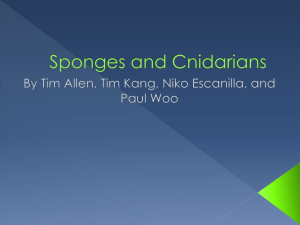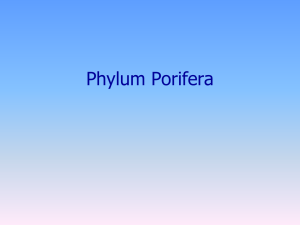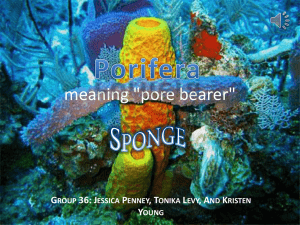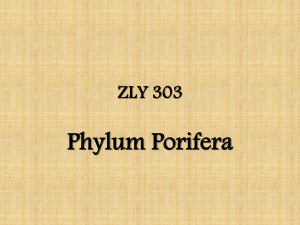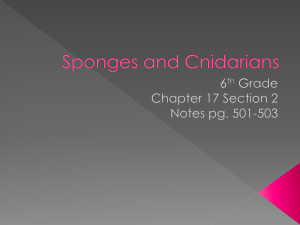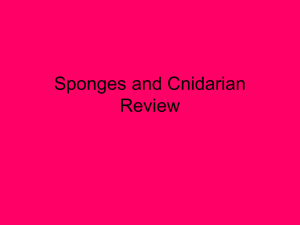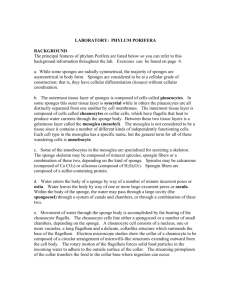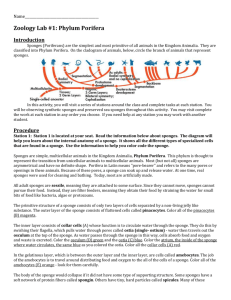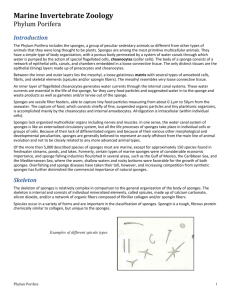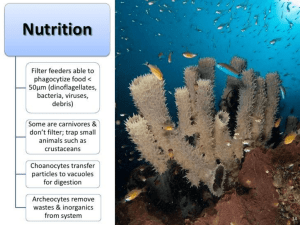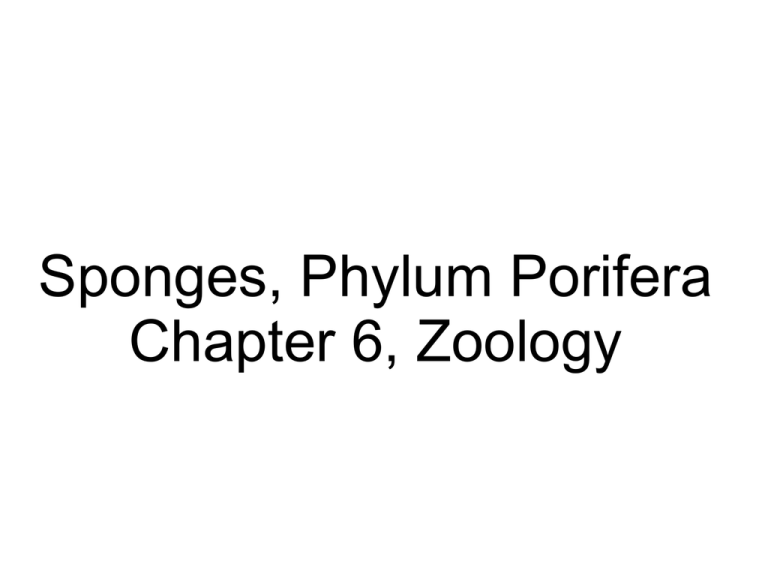
Sponges, Phylum Porifera
Chapter 6, Zoology
Phylum Porifera
Pronounced (po-rif'-er-a)
The name means “bearing pores”
Sponges are made up of a system of tiny pores and
canals that make up a intricate filter feeding system.
Sponges are sessile, meaning they have a stationary,
inactive lifestyle.
Their bodies are made up of thousands of cells mixed
together in a gel-like mixture, supported by small
structures called spicules made of calcium carbonate
or silica and collagen.
Phylum Porifera
Because they are sessile, they are highly dependent
on ocean currents to bring food to them and
eliminate waste products.
They have no organs or true tissues.
Digestion is intracellular. Respiration and excretion
occurs by simple diffusion. No nervous system.
Sponges are asymmetrical.
There are three main classes of sponges; Calcarea,
Hexactinellida, and Demospongiae.
Sponge Ecology
There are about 5000 sponge species.
About 97% are marine, 3% freshwater.
Embryos are free-swimming.
Adults are always attached to other objects. (rocks,
corals, submerged objects etc.)
Many other organisms such as crab and fish live
symbiotically in or on sponges.
Some sponges live on other organisms like molluscs
and corals.
Diversity of Sponges
Sponge Anatomy and Physiology
Their bodies are made of numerous tiny pores called Ostia
that allow water to flow into a sponge.
One to several large openings that allow water to flow out
of a sponge are called Oscula.
A singular Oscula is called an Osculum.
Small cells that line the canals of a sponge with whiplike
flagella are called Choanocytes.
The flagella on the choanocytes maintain the flow of water
through the canals.
The choanocytes also trap food particles.
Sponge Anatomy and Physiology
Sponge Canal Systems
Sponges have three types of canal systems;
Asconoid, Syconoid, and Leuconoid.
Sponge Canal Systems
Asconoid Sponges
(Flagellated Spongocoels)
Asconoids have the simplest body plan of the
sponges. They are small and tube shaped.
Water enters the ostia into a large cavity called the
Spongocoel.
The choanocytes then expel the water out the osculum.
Asconoids are found only in the class Calcarea.
Asconoid Sponges
(Leucosolenia sp.)
Syconoid Sponges
(Flagellated Canals)
Similar to Asconoids. Water is expelled through one
large osculum like in the asconoids.
Choanocytes do not line the spongocoel.
The choanocytes line individual canals along the sides
of the body tube called radial canals.
Syconoids are mostly found in class Calcarea.
Some are also found in class Hexactinellida
Syconoid Sponges
(Sycon sp.)
Leuconoid Sponges
(Flagellated Chambers)
The Leuconoid body plan is the most complex.
Their unique body design allows for a much greater body
size. The increased body size increases the amount of
flagellated choanocytes, therefore increasing the amount
of food that can be consumed.
Most leuconoids are large masses rather than simple
tubes, with numerous oscula.
There is no spongocoel in leuconoids.
They are found in all three classes of sponge.
Leuconoid Sponges
Cellular Structure of Sponges
The connective tissue of sponges consists of a loose gellike mixture called Mesohyl.
The epithelial cells of sponges are called Pinacocytes.
These cells play a role in trapping food particles.
Porocytes make up the ostia that allow the passage of
water into the sponge.
Archaeocytes are cells in the mesohyl that perform a
variety of functions such as digestion and production of
spicules and collagen.
Cellular Structure of a Sponge
Sponge Skeletons
An important structural protein in the animal
kingdom and in sponges is called collagen.
Thin strands of collagen are found throughout the
bodies of sponges.
The class of Demospongiae produces a form of
collagen known as spongin.
Various forms of spicules are found throughout the
different classes of sponges. They are made up of
Silica or Calcium Carbonate.
Sponge Skeleton
Spicules on the left
Spongin on the right
Sponge Metabolism
As mentioned earlier, various sponge cells such as
choanocytes and pinacocytes aid in digestion by
trapping food particles.
The primary cell type that actually metabolizes the
food are the archeocytes.
Respiration and excretion occur by diffusion.
All metabolic activities are highly dependent on a
constant flow of water from ocean currents.
Some sponges filter as much as 1500 liters/day!
Sponge Digestion
Sponge Reproduction
Sponges reproduce both sexually and asexually.
Most sponges are monoecious. Meaning a single
sponge can have both male and female sex cells.
Sperm cells develop from choanocytes. Egg cells can
develop from choanocytes in some species and from
archaeocytes in others.
Sponge Reproduction
After fertilization, the zygotes develop into a freeswimming flagellated larva called a parenchymula.
Paranchymula break off from the adult sponge and are
carried away by ocean currents.
Sponges can reproduce asexually by fragmentation (this
occurs when a fragment is broken off from the main body
of the sponge) and by external budding.
Budding occurs when a small sponge grows off of the adult
sponge. Eventually these can break off and regenerate.
Sponge Reproduction
Asexual reproduction can also occur by the formation of
internal buds called gemmules.
Gemmules are internal buds that are usually dormant
and contain archaeocytes.
Gemmules are formed during unfavorable conditions like
drought, freezing temperatures, and anoxia for long
periods of time.
After the unfavorable conditions pass, the archaeocytes
can then be released from the gemmules to regenerate
into a new sponge.
Sponge Larva and Gemmules
Parenchymula on
the right.
Gemmule on the
left
Class Calcarea
Spicules of calcium
carbonate (calcite
and limestone)
All three types of
canals represented
(asconoid, syconoid,
and leuconoid).
All marine
(Clathrina) Class
Calcarea
Class Hexactinellida
Six-rayed spicules
made of silica (same
substance as glass)
Body often
cylindrical and
funnel shaped
Syconoid or
leuconoid
All Marine
Venus Flower Basket
(Euplectella)
Class Demospongiae
Skeleton made of silica
spicules that are not sixrayed, or a skeleton made
of spongin, or both.
Leuconoid type canal
systems only.
One family freshwater, all
others are marine.
Very diverse group of
sponges


